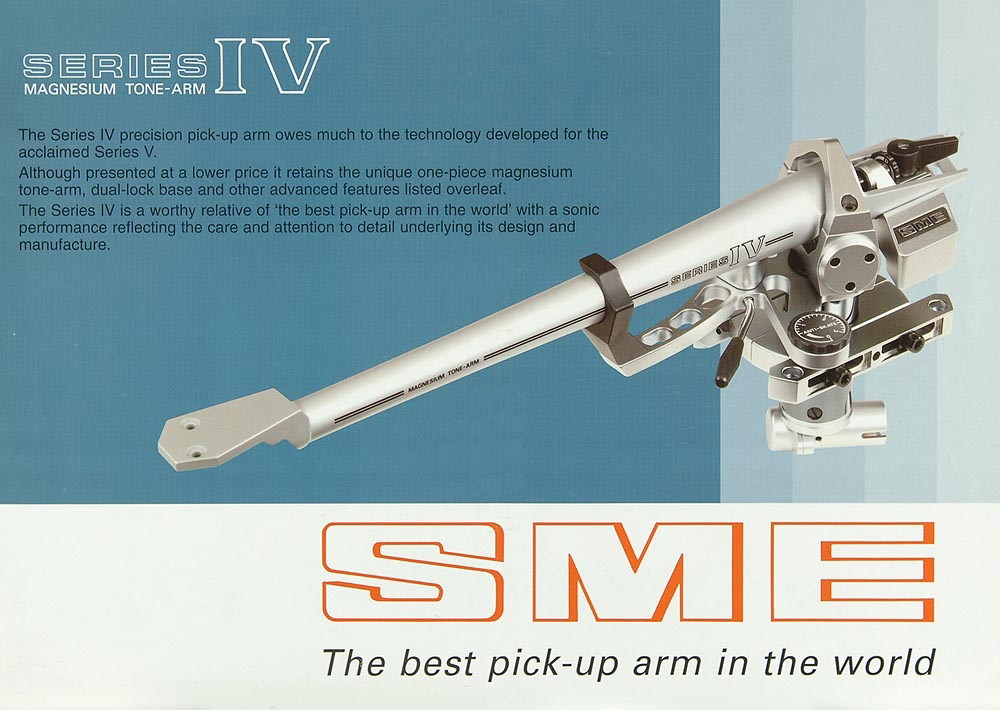SME Series IV
Data
General
- Manufacturer: SME
- Model: Series IV
- Type: Tonearm 9-inch
- Years of manufacture: 1991 -
- New price approx.: 2'300 DM (1991), 3'300 Euro (2020)
Technical Data
- Data at SME [1]
Comments
- Other models in the same series:
- SME Series IV
- SME Series V
Pictures
- Image: SME Series IV in 9-inch version
- Excerpt from Manual: SME Series IV
Reports
- Report SME Series IV tonearm (E):
The SME Series IV precision tone arm owes much to the technology developed for the acclaimed Series V. Although presented at a lower price it retains the unique one-piece magnesium tone-arm, dual-lock base and other advanced features listed. The SME Series IV precision Tone arm is a worthy relative of 'the best pick-up arm in the world' with a sonic performance reflecting the care and attention to detail underlying its design and manufacture. The SME Series IV is also available with a detachable head shell.
The SME Series IV precision Tone arm differs from the more expensive SME V Series in several ways. First there is a threaded VTA adjuster and damper available as an (expensive) option, the V has it as standard. Second the down force is altered by a simple dial where with the IV you have to count turns on a tiny vernier as it winds the weight back and forth.
In common with any mechanical device the behaviour of a pick-up arm is governed by three properties of matter that also define the laws of motion. The first property is mass which opposes any change in motion. The effective mass of an arm and cartridge resists motion at low frequencies but increasingly as frequency rises. It is this resisting force which makes the operation of a cartridge possible. At subsonic frequencies the armature and stator move as one allowing the slow movements needed to negotiate the record surface without generating a signal. At audio frequencies however the increased resisting force causes the armature to move relative to the stator and a signal is produced. The transition point between these two conditions is important for a clean low frequency response and is established by the compliance of the cartridge and the total effective mass of the arm and cartridge body.
The second property is stiffness which resists bending or flexing. It is a restoring force, proportional to position or deflection.
The third property is damping or resistance to motion. Here motion means velocity and without it there is no damping. The total equation of force acting on a pick-up arm is therefore the sum of three parts: acceleration acting on the mass, velocity acting on the internal or applied damping, and bending or deflection acting on the stiffness.
- Simple set-up even easier, here some will argue that the sprung down force dial is sonically superior to the simple see-saw balance of the IV Series. The only other difference is in the wiring. The SME Series IV precision Tone arm uses copper Litz internal wiring and the SME V Series Tone arm silver, the lead out cable is VDH on the V Series, OFC copper on the SME Series IV precision Tone arm.
Here there will be a sonic difference, the silver sounding brighter and a little more incisive if my comparisons of other silver cables are applicable. This may or may not be an improvement depending on your system and tastes though the lead out is undoubtedly better, a possible later upgrade? To my mind this makes the IV better value sonically than the V. But - that VTA adjuster is a tempting proposition and its cost puts the SME Series IV precision Tone arm much closer to the V Series. Unique one-piece pressure die-cast tone-arm utilising the advantages of magnesium, replaces conventional fabricated construction. Internal constrained layer damps minute residual vibration leaving the tone-arm acoustically inert. Fine machined cartridge platform, enamel free to avoid interface resonance. Stainless steel cross shaft, ground and thread ground. Carried in massive yoke on 10mm ABEC 3 ball races. Axis at record mean level to minimise warp-wow. Unique assembly gives high rigidity and allows bearings to be critically adjusted before tone-arm is fitted. Stainless steel vertical shaft, ground and thread ground, with integral 16mm diameter flange to couple shaft and yoke. 23mm diameter steel pillar, heat treated, ground and honed, carries two 17mm ABEC 7 ball races, widely spaced to resist tilt. Anti-skate control operates through tension spring and filarnent. Dial corresponds with VTF and has positive OFF position. Lowering/raising control gives smooth positive action. Height of lift can be adjusted. Dual-lock base provides movement control with high rigidity. Tungsten-alloy balance weight carried on damped two-point suspension. Extra-low inertia design assists warp riding. Under slung weight housing corrects centre of gravity and provides non-reflective tone-arm termination. Adjustment lead screw journalled in twin ball races with lever clamping. Swivelling damped output socket minimises vibration transmission in sub-chassis use. Reference lines on tone-arm facilitate VTA setting. Fine adjustment of horizontal tracking angle (HTA). New design alignment protractor sets HTA with great accuracy.
